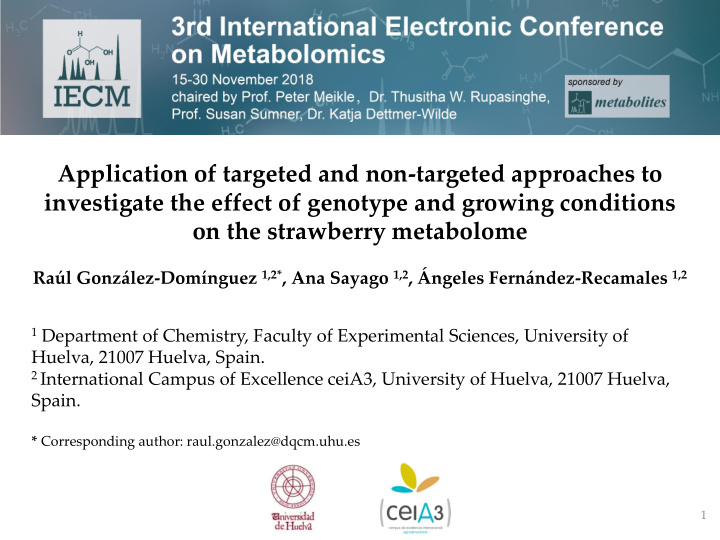



Application of targeted and non-targeted approaches to investigate the effect of genotype and growing conditions on the strawberry metabolome Raúl González-Domínguez 1,2* , Ana Sayago 1,2 , Ángeles Fernández-Recamales 1,2 1 Department of Chemistry, Faculty of Experimental Sciences, University of Huelva, 21007 Huelva, Spain. 2 International Campus of Excellence ceiA3, University of Huelva, 21007 Huelva, Spain. * Corresponding author: raul.gonzalez@dqcm.uhu.es 1
Application of targeted and non-targeted approaches to investigate the effect of genotype and growing conditions on the strawberry metabolome 2
Abstract: Strawberry is composed of numerous primary metabolites (sugars, amino acids, organic acids) and secondary metabolites (anthocyanins, flavan-3-ols, phenolic acids), which play an essential role in fruit quality, organoleptic characteristics and healthy benefits. In this context, metabolomics presents a great potential to get a deep overview of this complex chemical meshwork, which can provide valuable information on the effect of variety and agronomic conditions in the strawberry composition. We conducted a GC/MS-based non- targeted metabolomic analysis in strawberries of three varieties with different sensitivity to environmental conditions (Camarosa, Festival and Palomar), which in turn were grown in soilless systems by using various agronomic conditions (electrical conductivity, coverage and substrates). Complementarily, a targeted metabolomic approach based on UHPLC-MS/MS was also applied to identify and quantitate the main polyphenol compounds in these strawberry fruits. The most discriminant metabolites were several amino acids, sugars, organic acids, anthocyanins, ellagic acid derivatives, flavan-3-ols, chlorogenic acid and quercetin 3-O-glucuronide, which could be associated with differences in organoleptic characteristics and the biosynthesis of strawberry antioxidants. Keywords: metabolomics; strawberry; GC-MS, polyphenols 3
Introduction Secondary metabolites Primary metabolites Anthocyanins Sugars Organic acids Flavan-3-ols Lipids Ellagitannins Amino acids Phenolic acids fruit quality organoleptic characteristics healthy benefits 4
Introduction Un-targeted metabolomics Targeted metabolomics + Variety Growth conditions Agricultural practices Response to biotic and abiotic stress Post-harvest factors 5
Materials and Methods cv. Palomar + sensitivity to cv. Festival environmental stress Extraction with methanol-water cv. Camarosa - Derivatization and non-targeted Growing conditions analysis by GC-MS (primary metabolites) 1 • Macrotunnel type: covered vs. uncovered Analysis by targeted LC-MS/MS • Electrical conductivity: 1, 2 and 3 dS / m (secondary metabolites) 2 • Soilless commercial substrates: coconut fiber, perlite and rockwool (1) Plant Physiol. Biochem. 101 (2016) 14-22 (2) J. Agric. Food Chem. 65 (2017) 9559-9567 6
Results and Discussion Effect of variety on metabolomic profiles citric acid glucose, fructose organoleptic quality of strawberry osmotic adjustment and protection of alanine, norvaline, threonine, biochemical pathways aspartate inositol accumulation in osmotically challenged plants anthocyanins, ellagic acid up-regulation of the shikimate and rhamnoside, quercetin 3-O- malonate pathways glucuronide, procyanidin B2 tolerance mechanisms in response to cv. Camarosa environmental stress (resistant cultivar)
Results and Discussion Effect of macrotunnel type on metabolomic profiles strawberries are grown under controlled conditions, covered macrotunnel light intensity is reduced; temperature is higher; and moisture is controlled by regular irrigation malic acid low sun exposure threonine norvaline fructose humid climate anthocyanins, ellagic acid derivatives reduced light intensity and higher temperature 8
Results and Discussion Effect of electrical conductivity on metabolomic profiles higher electrical conductivity citric acid, malic acid increase of osmoprotectants and antioxidants, decrease of essential amino alanine acids and TCA derivatives (mainly detected in more resistant cultivars, i.e. Camarosa) inositol glycerol response to osmotic stress (increased salt anthocyanins content) 9
Results and Discussion Effect of substrate on metabolomic profiles coconut fiber citric acid increase of sugars and organic acids (organoleptic characteristics of fruits) and glucose, fructose polyphenols (bioactive compounds) anthocyanins ellagic acid derivatives coconut fiber is the best substrate for the production of strawberry in soilless culture 10
Conclusions Combined non-targeted and targeted metabolomics has a great potential to investigate the effect of variety and agronomic practices on strawberry composition cv. Camarosa (resistent cultivar) has increased levels of amino acids, inositol and polyphenols as a consequence of tolerance mechanisms in response to environmental stress Cultivation in covered macrotunnel induces an specific metabolic profile due to reduced light exposure, higher temperature and humidity Higher conductivity of irrigation leads to the increase of osmoprotectants and antioxidants, and the decrease of essential amino acids and TCA derivatives as a consequence of the response to osmotic stress Strawberries grown in coconut fiber have increased content of sugars, organic acids and polyphenols 11
Recommend
More recommend